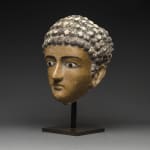Egyptian Painted Plaster Funerary Mask of a Man, 2nd Century CE - 2 BCE
Plaster, Glass
height 24.4 cm
height 9 5/8 in
height 9 5/8 in
X.0177
This gorgeous plaster funerary mask reveals that the traditional Egyptian arts continued to flourish even under Roman rule. In fact, the Egyptian style was reinvigorated with a healthy dose of...
This gorgeous plaster funerary mask reveals that the traditional Egyptian arts continued to flourish even under Roman rule. In fact, the Egyptian style was reinvigorated with a healthy dose of Roman classicism that elegantly merges with the stylized traditions of Egypt.
Our portrait head depicts a young man in the prime of his life. His hair is arranged in a style fashionable among Roman aristocrats in during the first half of the first century AD, at which time Egypt was administered by agents of the Roman emperors. His facial features are rendered in an idealizing manner so that he might be able to spend eternity in perfect health. His skin tones are rendered in a light-brownish hue. His mouth is small with a slightly fleshier lower lip, his nose thin-bridged, his eyes brows, plastically rendered as paint stripes and painted black, as are the horizontally arranged rows of tight curls of his hair. His large, almond-shaped eyes are inlaid with glass and sparkle in a manner that imbues the face with a life-like, realistic quality which is enhanced by the presence of painted eye lashes.
Objects such as our portrait were placed over the heads of mummies of elite members of Egypt’s aristocracy during the Roman Imperial Period. These individuals may have been highly placed members of the bureaucracy of the time, and proclaimed their allegiance to Rome by their dress and coiffures. Such Egyptian creations find their closest parallels in Roman portraits in marble of the period, and are to be considered as belonging to that rich tradition of Roman portraiture.
References:
For a very close parallel not only with regard to the hair style but also with regard to the skin tones, see, London, The British Museum 30845: Klaus Parlasca, Mumienporträts und verwandte Denkmäler (Wiesbaden 1966), pages 121 and 123 with plate 3, figure 1, which is assigned to Upper Egypt and is tentatively dated to the reign of the Roman Emperor Augustus; and London, The British Museum GRA1988.9-20.21: Klaus Parlasca and Hellmut Seemann [editors], Augenblicke. Mujmienporträts und ägyptische Grabkunst aus römischer Zeit (Munich 1999), pages 108-109, catalogue number 7, for a limestone head of a youthful Roman excavated at Hawara by Sir Flinders Petrie with a coiffure identical to ours. This example is dated to the first half of the first century AD.
Our portrait head depicts a young man in the prime of his life. His hair is arranged in a style fashionable among Roman aristocrats in during the first half of the first century AD, at which time Egypt was administered by agents of the Roman emperors. His facial features are rendered in an idealizing manner so that he might be able to spend eternity in perfect health. His skin tones are rendered in a light-brownish hue. His mouth is small with a slightly fleshier lower lip, his nose thin-bridged, his eyes brows, plastically rendered as paint stripes and painted black, as are the horizontally arranged rows of tight curls of his hair. His large, almond-shaped eyes are inlaid with glass and sparkle in a manner that imbues the face with a life-like, realistic quality which is enhanced by the presence of painted eye lashes.
Objects such as our portrait were placed over the heads of mummies of elite members of Egypt’s aristocracy during the Roman Imperial Period. These individuals may have been highly placed members of the bureaucracy of the time, and proclaimed their allegiance to Rome by their dress and coiffures. Such Egyptian creations find their closest parallels in Roman portraits in marble of the period, and are to be considered as belonging to that rich tradition of Roman portraiture.
References:
For a very close parallel not only with regard to the hair style but also with regard to the skin tones, see, London, The British Museum 30845: Klaus Parlasca, Mumienporträts und verwandte Denkmäler (Wiesbaden 1966), pages 121 and 123 with plate 3, figure 1, which is assigned to Upper Egypt and is tentatively dated to the reign of the Roman Emperor Augustus; and London, The British Museum GRA1988.9-20.21: Klaus Parlasca and Hellmut Seemann [editors], Augenblicke. Mujmienporträts und ägyptische Grabkunst aus römischer Zeit (Munich 1999), pages 108-109, catalogue number 7, for a limestone head of a youthful Roman excavated at Hawara by Sir Flinders Petrie with a coiffure identical to ours. This example is dated to the first half of the first century AD.



